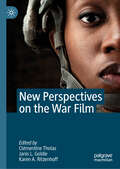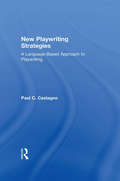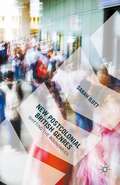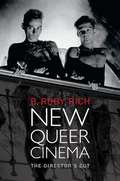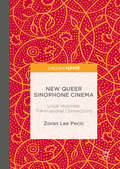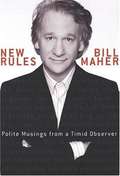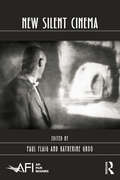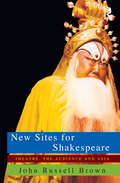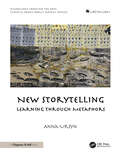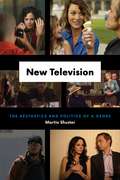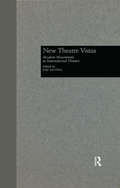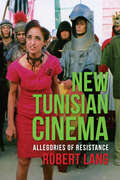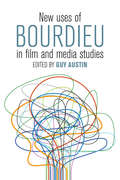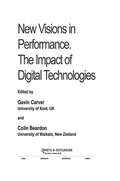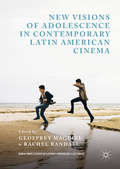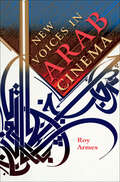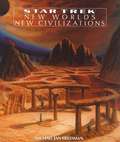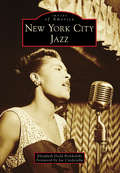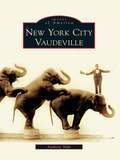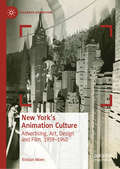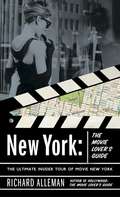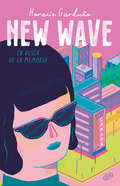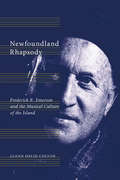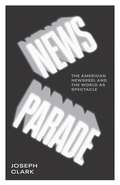- Table View
- List View
New Perspectives on the War Film
by Karen A. Ritzenhoff Clémentine Tholas Janis L. GoldieNew Perspectives on the War Film addresses the gap in the representation of many forgotten faces of war in mainstream movies and global mass media. The authors concentrate on the untold narratives of those who fought in combat and were affected by its brutal consequences. Chapters discuss the historically under-represented stories of individuals including women, African-American and Indigenous Soldiers. Issues of homosexuality and gender relations in the military, colonial subjects and child soldiers, as well as the changing nature of war via terrorism and bioterrorism are closely analyzed. The contributors demonstrate how these viewpoints have been consistently ignored in mainstream, blockbuster war sagas and strive to re-integrate these lost perspectives into current and future narratives.
New Playwriting Strategies: A Language-Based Approach to Playwriting
by Paul C. CastagnoNew Playwriting Strategies offers a fresh and dynamic approach to playwriting that will be welcomed by teachers and aspiring playwrights alike.
New Postcolonial British Genres: Shifting the Boundaries
by Sarah IlottThis study analyses four new genres of literature and film that have evolved to accommodate and negotiate the changing face of postcolonial Britain since 1990: British Muslim Bildungsromane, gothic tales of postcolonial England, the subcultural urban novel and multicultural British comedy.
New Queer Cinema: The Director's Cut
by B. Ruby RichB. Ruby Rich designated a brand new genre, the New Queer Cinema (NQC), in her groundbreaking article in the Village Voice in 1992. This movement in film and video was intensely political and aesthetically innovative, made possible by the debut of the camcorder, and driven initially by outrage over the unchecked spread of AIDS. The genre has grown to include an entire generation of queer artists, filmmakers, and activists. As a critic, curator, journalist, and scholar, Rich has been inextricably linked to the New Queer Cinema from its inception. This volume presents her new thoughts on the topic, as well as bringing together the best of her writing on the NQC. She follows this cinematic movement from its origins in the mid-1980s all the way to the present in essays and articles directed at a range of audiences, from readers of academic journals to popular glossies and weekly newspapers. She presents her insights into such NQC pioneers as Derek Jarman and Isaac Julien and investigates such celebrated films as Go Fish, Brokeback Mountain, Itty Bitty Titty Committee, and Milk. In addition to exploring less-known films and international cinemas (including Latin American and French films and videos), she documents the more recent incarnations of the NQC on screen, on the web, and in art galleries.
New Queer Sinophone Cinema
by Zoran Lee PecicThis book looks closely at some of the most significant films within the field of queer Sinophone cinema. Examining queerness in films produced in the PRC, Taiwan and Hong Kong, the book merges the Sinophone with the queer, theorising both concepts as local and global, homebound as well as diasporic. Queerness in this book not only problematises the positioning of non-normative desires within the Sinophone; it also challenges Eurocentric critical perspectives on filmic representation that are tied to the idea of the binary between East/West. New Queer Sinophone Cinema will appeal to scholars in Chinese and film studies, as well as to anyone who is interested in queer Chinese cinema.
New Rules: Polite Musings from a Timid Observer
by Bill MaherNo one is safe from Maher's scathing, acerbic humor in this hilarious collection of new rules of life.
New Silent Cinema: Digital Anachronisms, Celluloid Spectacles (AFI Film Readers)
by Katherine Groo Paul FlaigWith the success of Martin Scorsese’s Hugo (2011) and Michel Hazanavicius’s The Artist (2011) nothing seems more contemporary in recent film than the styles, forms, and histories of early and silent cinemas. This collection considers the latest return to silent film alongside the larger historical field of visual repetitions and affective currents that wind their way through 20th and 21st century visual cultures. Contributors bring together several fields of research, including early and silent cinema studies, experimental and new media, historiography and archive theory, and studies of media ontology and epistemology. Chapters link the methods, concerns, and concepts of early and silent film studies as they have flourished over the last quarter century to the most recent developments in digital culture—from YouTube to 3D—recasting this contemporary phenomenon in popular culture and new media against key debates and concepts in silent film scholarship. An interview with acclaimed Canadian filmmaker Guy Maddin closes out the collection.
New Sites For Shakespeare: Theatre, the Audience, and Asia
by John Russell BrownIn the course of exploring the theatrical cultures of South and East Asia, eminent Shakespeareanist John Russell Brown developed some remarkable theories about the nature of performance, the state of Western 'Theatre' today, and the future potential of Shakespeare's plays. In New Sites for Shakespeare he outlines his passionate belief in the power of theatre to reach mass audiences, based on his experiences of popular Asian performances. It is a personal polemic, but it is also a carefully argued and brilliantly persuasive study of the kind of theatrical experience Shakespeare's own contemporaries enjoyed. This is a book which cannot be ignored by anyone who cares about the live performing arts today. Separate chapters consider staging, acting, improvisation, ceremonies and ritual, and an analysis of the experience of the audience is paramount throughout.
New Storytelling: Learning through Metaphors
by Anna UrsynThere is a global need to become less fearful of coding, as it improves communication with the coders on the job and helps with prompt writing, which hiring companies often request. This set of story-based learning projects links performances and tasks with computing codes to show how a machine translates our goals into its language. Metaphors link instructions telling a computer what task to perform with similar functions in other disciplines. The materials serve those in Computer Graphics, Digital Media, or anyone interested in understanding and becoming familiar with principles and the logic behind coding, and help understand machines when writing a prompt. Dance, music, and performing visually present knowledge through stories and serve as a metaphor for understanding how coding and current technologies affect various disciplines. By introducing basic ideas behind programming in a symbolic way, this book shows how computing and nature overlap through storytelling.Most jobs are collaborative, and coding involves many parts of production processes. These knowledge-based stories improve communication between the artists and the coders to bridge the gap between them.It is a part of the “Knowledge Through the Arts” series, consisting of:Dance Code - Dance Steps as a CodeNew Storytelling - Learning Through MetaphorsCode Appreciation - Reshaping KnowledgeNature Appreciation - Knowledge as Art
New Television: The Aesthetics and Politics of a Genre
by Martin ShusterEven though it’s frequently asserted that we are living in a golden age of scripted television, television as a medium is still not taken seriously as an artistic art form, nor has the stigma of television as “chewing gum for the mind” really disappeared. Philosopher Martin Shuster argues that television is the modern art form, full of promise and urgency, and in New Television, he offers a strong philosophical justification for its importance. Through careful analysis of shows including The Wire, Justified, and Weeds, among others; and European and Anglophone philosophers, such as Stanley Cavell, Hannah Arendt, Martin Heidegger, and John Rawls; Shuster reveals how various contemporary television series engage deeply with aesthetic and philosophical issues in modernism and modernity. What unifies the aesthetic and philosophical ambitions of new television is a commitment to portraying and exploring the family as the last site of political possibility in a world otherwise bereft of any other sources of traditional authority; consequently, at the heart of new television are profound political stakes.
New Theatre Vistas: Modern Movements in International Literature (Studies in Modern Drama)
by Judy L. OlivaFirst Published in 1996. Part of a series of ‘Studies in Modern Drama’, Volume 7 This volume Studies in Modern Drama collects essays on contemporary theatre which reveal the changing face of the world, as well as challenges to the boundaries of traditional stage production. Authors examine familiar texts in new settings, discovering what editor Judy Lee Oliva calls “the effect of cultural- specific gestures, stances and the nuance of words,” so that audiences and critics are forced to recognize stereotypes and re-evaluate older critical methods. Topics range from directing gay and working-class theatre in Scotland to producing American and British drama in Holland, Belgium, and Poland. New voices in the theatre are heard, and old ones are put to new tests. What remains is the power of performance to inspire emotional and intellectual response. Writers, directors, costume designers, producers, and critics provide an uncommon range of perspectives to the changing roles of theatre in an increasingly global community.
New Tunisian Cinema: Allegories of Resistance (Film and Culture Series)
by Robert LangTunisian cinema is often described as the most daring of all Arab cinemas. For many, Tunisia appeared to be a model of equipoise between "East" and "West," and yet, during Zine El Abidine Ben Ali's presidency, from 1987 to 2011, the country became the most repressive state in the Maghreb. Against considerable odds, a generation of filmmakers emerged in the mid-1980s to make films that are allegories of resistance to the increasingly illiberal trends that were marking their society.In New Tunisian Cinema, Robert Lang focuses on eight films by some of the nation's best-known directors, including Man of Ashes (1986), Bezness (1992) and Making Of (2006) by Nouri Bouzid, Halfaouine (1990) by Férid Boughedir, The Silences of the Palace (1994) by Moufida Tlatli, Essaïda (1997) by Mohamed Zran, Bedwin Hacker (2002) by Nadia El Fani, and The TV Is Coming (2006) by Moncef Dhouib. He explores the political economy and social, historical, and psychoanalytic dimensions of these works and the strategies filmmakers deployed to preserve cinema's ability to shape debates about national identity. These debates, Lang argues, not only helped initiate the 2011 uprising that ousted Ben Ali's regime but also did much to inform and articulate the aspirations of the Tunisian people in the new millennium.
New Uses of Bourdieu in Film and Media Studies
by Guy AustinThrough his influential work on cultural capital and social mobility, the French sociologist Pierre Bourdieu has provided critical insights into the complex interactions of power, class, and culture in the modern era. Ubiquitous though Bourdieu's theories are, however, they have only intermittently been used to study some of the most important forms of cultural production today: cinema and new media. With topics ranging from film festivals and photography to constantly evolving mobile technologies, this collection of essays demonstrates the enormous relevance that Bourdieu's key concepts hold for the field of media studies, deploying them as powerful tools of analysis and forging new avenues of inquiry in the process.
New Visions In Performance: The Impact Of Digital Technologies (Innovations in Art and Design)
by Gavin Carver Colin BeardonNew Visions in Performance features the work of twelve performers and academics who are concerned with the integration of digital technologies into theatrical performance.
New Visions of Adolescence in Contemporary Latin American Cinema (New Directions in Latino American Cultures)
by Rachel Randall Geoffrey MaguireThis volume explores the recent ‘adolescent turn’ in contemporary Latin American cinema, challenging many of the underlying assumptions about the nature of youth and distinguishing adolescence as a distinct and vital area of study. Its contributors examine the narrative and political potential of teenage protagonists in a range of recent films from the region, acknowledging the distinct emotional registers that are at play throughout adolescence and releasing teenage subjectivities from restrictive critical and theoretical emphases on theories of childhood. As the first academic study to examine the figure of the adolescent in contemporary Latin American film, New Visions of Adolescence in Contemporary Latin American Cinema thus presents a timely and innovative analysis of issues of sexuality and gender, political and domestic violence and social class, and will be of significant interest to students and researchers in Latin American Studies, Cultural Studies, World Cinema and Childhood Studies.
New Voices in Arab Cinema
by Roy ArmesNew Voices in Arab Cinema focuses on contemporary filmmaking since the 1980s, but also considers the longer history of Arab cinema. Taking into consideration film from the Middle East and North Africa and giving a special nod to films produced since the Arab Spring and the Syrian crisis, Roy Armes explores themes such as modes of production, national cinemas, the role of the state and private industry on film, international developments in film, key filmmakers, and the validity of current notions like globalization, migration and immigration, and exile. This landmark book offers both a coherent, historical overview and an in-depth critical analysis of Arab filmmaking.
New Worlds, New Civilizations: Star Trek All Series (Star Trek)
by Michael Jan FriedmanThey said it couldn't be done ... all the myriad worlds which have been sought out and explored through more than 500 television episodes and nine Star Trek movies, mapped, illustrated and brought to life in the pages of a comprehensive Star Trek atlas. From the comparatively crowded space of the Alpha and Beta Quadrants, home to Earth and Vulcan, Bajor and Betazed, the Cardassian Union and the Romulan and Klingon Empires; to the distant Gamma Quadrant controlled by the Dominion; to the far reaches of the Delta Quadrant, home space of the Borg, where of Federation explorers only the crew of the USS Voyager has ever been; NEW WORLDS, NEW CIVILIZATIONS catalogues peoples and planets from all four corners of the galaxy. Ever wondered where the blue-skinned Bolians originated from? Or what it is like on the permanently frozen homeworld of the bloodless Breen? From the first world that the first away team landed on under the command of Christopher Pike in the original pilot episode 'The Cage' (a world that has been off-limits to the Federation ever since), to the world of the Ba'ku as seen in 'Star Trek: Insurrection', all these and many more are described and depicted in all their fascinating detail by a team of star-studded contributors. Produced in the finest tradition of bestselling Star Trek illustrated reference from Pocket Books such as The Art of Star Trek and Where No Man Has Gone Before, NEW WORLDS, NEW CIVILIZATIONS will be an essential addition to every Trekker's shelves.
New York City Jazz
by Elizabeth Dodd Brinkofski Joe CinderellaNew York City Jazz explores many of the haunts and hideaways that have played host to iconic jazz musicians and singers like Charlie Parker, Miles Davis, John Coltrane, Bill Evans, Billie Holiday, Dizzy Gillespie, and Lester Young. Considered the jazz capital of the world, New York City is known for its flashy venues. The stages of the Latin Quarter, Apollo Theater, Minton's Playhouse, Onyx, Stork Club, Downbeat Club, Birdland, Roseland, and Copacabana came to life with the sounds of pianos, drums, horns, and gypsy guitars. This collection of images presents why Fifty-second Street was nicknamed "Swing Street" and how musicians made timeless names for themselves in the Empire City.
New York City Vaudeville
by Anthony SlideNew York City Vaudeville provides a unique pictorial record of America's preeminent entertainment medium in the late 1800s through the early 1930s. New York's Palace Theatreserved as the flagship for vaudeville, on which stage everyvaudevillian aspired to perform. New York City Vaudevillefeatures photographs of some of the greatest names fromthe Palace Theatre, including Jack Benny, George Burnsand Gracie Allen, Anna Held, the Marx Brothers, and Eva Tanguay, as well as legendary African American performers such as Bill Robinson, Ethel Waters, and Bert Williams. Through the photographs and the capsule biographies, the reader is transported back to a time when vaudeville was the people's entertainment, with a new bill of fare each week and an ever-changing number of performers with ever-changing styles of presentation.
New York's Animation Culture: Advertising, Art, Design and Film, 1939–1940 (Palgrave Animation)
by Kristian MoenThis book reveals and explores the thriving animation culture in midtown Manhattan, the World’s Fair, art galleries and cinemas during a vibrant period of artistic, commercial and industrial activity in New York City. Alongside a detailed investigation of animated film at the time – ranging from the abstract works of Mary Ellen Bute and Norman McLaren to the exhibition practices of the Disney Studios and the New York World’s Fair – New York’s Animation Culture examines a host of other animated forms, including moving dioramas, illuminated billboards, industrial displays, gallery exhibitions, mobile murals, and shop windows. In this innovative microhistory of animation, Moen combines the study of art, culture, design and film to offer a fine-grained account of an especially lively animation culture that was seen as creating new media, expanding the cinema experience, giving expression to utopian dreams of modernity, and presenting dynamic visions of a kinetic future.
New York: The Movie Lover's Guide
by Richard AllemanThe classic guide to who-did-what-where in New York, on- and off-screen, including: Classic film and TV locations: Marilyn Monroe's infamous Seven Year Itch subway grating . . . the deli where Meg Ryan famously faked an orgasm in When Harry Met Sally . . . the diner where Courteney Cox (in Friends) and Kirsten Dunst (in Spider-Man) waitressed . . . Men in Black's Manhattan headquarters . . . The Godfather mansion on Staten Island...the Greenwich Village apartment where Jack Nicholson terrorized Greg Kinnear in As Good as It Gets . . . Ghostbusters' Tribeca firehouse . . . Michael Douglas and Gwyneth Paltrow's A Perfect Murder palazzo . . . the landmark West Side building that housed Tom Cruise in Vanilla Sky and Mia Farrow in Rosemary's Baby . . . the Greenwich Village apartment of Friends . . . Will & Grace's Upper West Side building . . . The All in the Family block in Queens . . . The Sopranos' New Jersey mansion (and the real Bada Bing club) . . . Seinfeld's favorite diner . . . Sex and the City's sexiest haunts . . . and many more . . . Stars' childhood homes: Lena Horne's Bedford-Stuyvesant townhouse . . . Frank Sinatra's Hoboken row house . . . Barbra Streisand's Flatbush housing project . . . J.Lo's Bronx block . . . Humphrey Bogart's Upper West Side tenement . . . the Marx Brothers' Upper East Side brownstone . . . Apartments and townhouses of the silver screen's greatest legends: Joan Crawford . . . Marlene Dietrich . . . James Dean . . . Katharine Hepburn . . . Montgomery Clift . . . Rita Hayworth . . . Rock Hudson . . . and . . . Plus: Superstar cemeteries . . . major film and TV studios . . . historic movie palaces and Broadway theaters . . . star-studded restaurants and legendary hotels . . . For movie-loving New Yorkers, travelers and armchair film buffs, New York: The Movie Lover's Guide is the ultimate insider's guide to the Big Apple's reel attractions.
New wave. En busca de la memoria
by Horacio GarduñoTres chicos, un mal recuerdo perdido en el limbo y una banda post punk. Lucrecia canta en una banda punk y se expresa con intensidad inusual, con una energía brutal en el escenario, y vaya que tiene un mundo interior por manifestarse, pues su vida en casa no ha sido fácil. La música es su vía de desfogue. En su mente hay otra Lucrecia, más inocente, que ha olvidado su pasado a causa de una experiencia traumática. Pero cuando conoce a Juan José, un baterista que se deja llevar por el trance de la música, las cosas empiezan a reacomodarse de forma extraña. Lucre busca recuperar sus memorias y las escribe en una libreta. Pero aún debe ahondar en ciertos recuerdos, los más dolorosos. Un día llegan dos personas al hoyo funky donde debuta su banda, una del pasado de Lucre y otra de su futuro, ambas la harán entrar en un dilema que la enfrentará con aquello que tanto teme. Explora los viajes y las subrealidades de la mente humana en el tiempo y en el espacio. Una nueva ola de la vida a pesar de los goles recibidos.
Newfoundland Rhapsody
by Glenn David ColtonFrederick Rennie Emerson (1895-1972) was a dynamic presence in the cultural and intellectual life of Newfoundland and Labrador for much of the twentieth century. A musician, lawyer, educator, and folklore enthusiast, Emerson was a central figure in the preservation and mediation of Newfoundland culture in the tumultuous decades prior to and following Confederation with Canada in 1949. Glenn Colton shows how Emerson fostered greater awareness and understanding of Newfoundland's cultural heritage in local, national, and international contexts. His collaboration with song collector Maud Karpeles in the late 1920s preserved some of the most cherished folk songs in the English language, and a decade later, his lectures at Memorial University College emphasized folk traditions and classical repertoire to inspire cultural discovery for an entire generation. As Newfoundland's representative on the first Canada Council and vice-president of the Canadian Folk Music Society, he played a crucial role in shaping Canadian cultural policy during the transformative years of the mid-twentieth century. Colton also reveals the meaningful creative works Emerson composed in response to the same cultural heritage he documented and preserved: his one-act drama Proud Kate Sullivan (1940) is a pioneering depiction of Newfoundland life, and the folk-inspired Newfoundland Rhapsody (1964) is one of few examples of symphonic music composed by a Newfoundlander of his generation. Newfoundland Rhapsody explores Newfoundland society, Canada's emerging arts scene, and the international folk music community to offer a new lens through which to view the cultural history of twentieth-century Newfoundland and Canada.
Newfoundland Rhapsody: Frederick R. Emerson and the Musical Culture of the Island
by Glenn David ColtonFrederick Rennie Emerson (1895-1972) was a dynamic presence in the cultural and intellectual life of Newfoundland and Labrador for much of the twentieth century. A musician, lawyer, educator, and folklore enthusiast, Emerson was a central figure in the preservation and mediation of Newfoundland culture in the tumultuous decades prior to and following Confederation with Canada in 1949. Glenn Colton shows how Emerson fostered greater awareness and understanding of Newfoundland's cultural heritage in local, national, and international contexts. His collaboration with song collector Maud Karpeles in the late 1920s preserved some of the most cherished folk songs in the English language, and a decade later, his lectures at Memorial University College emphasized folk traditions and classical repertoire to inspire cultural discovery for an entire generation. As Newfoundland's representative on the first Canada Council and vice-president of the Canadian Folk Music Society, he played a crucial role in shaping Canadian cultural policy during the transformative years of the mid-twentieth century. Colton also reveals the meaningful creative works Emerson composed in response to the same cultural heritage he documented and preserved: his one-act drama Proud Kate Sullivan (1940) is a pioneering depiction of Newfoundland life, and the folk-inspired Newfoundland Rhapsody (1964) is one of few examples of symphonic music composed by a Newfoundlander of his generation. Newfoundland Rhapsody explores Newfoundland society, Canada's emerging arts scene, and the international folk music community to offer a new lens through which to view the cultural history of twentieth-century Newfoundland and Canada.
News Parade: The American Newsreel and the World as Spectacle
by Joseph ClarkA fascinating look at the United States&’ conflicted relationship with news and the media, through the lens of the newsreel When weekly newsreels launched in the early twentieth century, they offered the U.S. public the first weekly record of events that symbolized &“indisputable evidence&” of the news. In News Parade, Joseph Clark examines the history of the newsreel and how it changed the way Americans saw the world. He combines an examination of the newsreel&’s methods of production, distribution, and reception with an analysis of its representational strategies to understand the newsreel&’s place in the history of twentieth-century American culture and film history.Clark focuses on the sound newsreel of the 1930s and 1940s, arguing that it represents a crucial moment in the development of a spectacular society where media representations of reality became more fully integrated into commodity culture. Using several case studies, including the newsreel&’s coverage of Charles Lindbergh&’s transatlantic flight and the Sino–Japanese War, News Parade shows how news film transformed the relationship between its audience and current events, as well as the social and political consequences of these changes. It pays particular attention to how discourses of race and gender worked together with the rhetoric of speed, mobility, and authority to establish the power and privilege of newsreel spectatorship.In the age of fake news and the profound changes to journalism brought on by the internet, News Parade demonstrates how new technologies and media reshaped the American public&’s relationship with the news in the 1930s—a history that can help us to better understand the transformations happening today.
